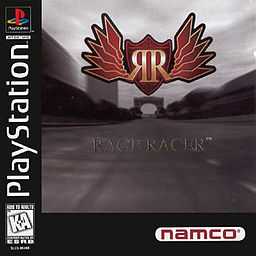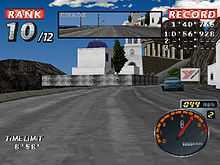Rage Racer
| Rage Racer | |
|---|---|
 | |
| Developer(s) | Namco |
| Publisher(s) | Namco |
| Platform(s) | Sony PlayStation |
| Release date(s) |
|
| Genre(s) | Racing |
| Mode(s) | Single player |
| Distribution | CD-ROM |
Rage Racer (レイジレーサー) is the third title in the Ridge Racer series of racing games on the Sony PlayStation. Created by Namco, it was first released in Japan on December 3, 1996. This game uses the same game's covers for all regional versions.[1]
Gameplay
Visually the game takes a different approach compared to the previous PlayStation titles. The game looks more realistic and has a darker color scheme, it takes a lot of this from the arcade game in the Ridge Racer series, Rave Racer. For the first time in the Ridge Racer series, Rage Racer introduces a brand new advanced singleplayer career system which uses credits. The player can get credits from winning races which can then be used to buy and upgrade cars.

- Game Structure
The racing is separated into five classes, named 'Class 1' through to 'Class 5'. The game's objective is to earn money (Credits, or 'eg'), which can be spent on new cars or on upgrading existing cars. There are three races in Grade 1 and Grade 2 - Mythical Coast, Over Pass City and Lakeside Gate. The Extreme Oval is introduced from Class 3.
The game begins with the player in Class 1 with the Gnade Esperanza, the game's only Grade 1 car. The player must place in the top three in all of each Classes' events to progress to the next class. Each class has 3 chances to try. This is different from the early Ridge Racer when the player can have unlimited restarts. The player must retire from the Grand Prix if all 3 chances had been tried and failed to get into the top 3 position. All of the money and cars that the player won stays, but the medals would be lost. If the player wins all three races in a class using the correct grade of car (e.g. a Grade 1 car in Class 1), the gold trophy for that class is earned. Otherwise, the player simply moves on to the next class. When the player has completed the five 'Normal GP' events, the 'Extra GP' is unlocked. This allows the player to race the same Classes on reversed courses. As well as unlocking the Extra GP, the player receives 999,999,999 e.g. in Normal GP - more than enough to purchase all of the cars and upgrade them to Grade 5. Upon finishing Class 5 in the Extra GP, Class 6 is unlocked, along with the three 'secret' cars. Although it's in the Extra GP, the races in Class 6 are driven on the forward tracks. Class 6 features only four opponents rather than the eleven faced in all other classes.
- Tracks
Rage Racer has four tracks, which all can be driven backwards as well as forwards. Compared to the tracks in the previous games, Rage Racer's tracks are very long and detailed, except for "The Extreme Oval", at 3,074m. The remaining 3 tracks are "Mythical Coast" (4,641m), "Over Pass City" (6,640m) and "Lakeside Gate" (6,237m). Rage Racer was also one of the only games in the series that did not feature an onscreen map during the race. "Mythical Coast" has a varied range of corners and hills, and suits an all-round vehicle such as the Gnade Esperanza. "Over Pass City" features many steep inclines, and suits the high acceleration Lizard vehicles. "Lakeside Gate" is a technical, twisting course, to which the quick handling Age cars are best suited. "The Extreme Oval" is a flat out oval with wide banked turns. The high speed Assoluto cars are most at home on this track.
- Vehicles
There are four car manufacturers in Rage Racer. Each of the four manufacturers favors a different attribute. Age cars are lightweight, and feature excellent handling. Lizard cars favor large displacement engines with high torque outputs which give their cars great acceleration. Assoluto cars are designed with maximum power and top speed in mind. The sole Gnade car, the Esperanza, is an all rounder with average stats in each area. With the exception of Gnade, each manufacturer has three 'standard' cars, and one 'secret' car. Age's three 'standard' cars are the Erriso (Alouette in Japanese version) at Grade 2, the Abeille at Grade 3 and the Pegase at Grade 4. Gnade's only car is the Esperanza. This is the first car you are given at the beginning of the game, and starts at Grade 1. Lizard produces the Acceron at Grade 2, the Bayonet at Grade 3 and the Hijack at Grade 4. Assoluto's cars are the Grade 3 Fatalita, the Istante at Grade 4, and the Ghepardo at Grade 5.
All of the 'standard' cars can be upgraded, with the cost increasing greatly from one grade to the next. The highest level to which the cars can be upgraded is Grade 5. This means the Assoluto Ghepardo cannot be upgraded, as it is a Grade 5 car as standard.
This is the first game in the Ridge Racer series that permits the player to race with a truck, but it only comes with manual transmission. The only truck in this game is the Lizard Hijack, and is available from Class 4 in the game. In the extra Grand prix, there is an extra Grade 6 class where you can buy 'secret' cars. These cars are called the Age Vainqure [2,000,000 eg], Lizard Bulldog [3,700,000 eg] and the Assoluto Squaldon [6,666,666 e.g., an allusion to the Squaldon's 'Devil car' status]. The Age can go around most of the game's corners flat out at the car's top speed, the Lizard can accelerate up steep inclines as if they weren't there, and the Assoluto has a top speed in excess of 360 km/h. The 'secret' cars are known by different names in the Japanese version of the game. The Vainqure is called the 'Victoire', the Bulldog the 'Tempest', and the Squaldon the 'Dragone'.
The Makes are particular for different courses. Age is for "Lakeside Gate", Lizard is for "Over Pass City", Gnade is for "Mythical Coast" and Assoluto is for "The Extreme Oval".
Prologues differences between Japanese and North America version
At the very beginning of the whole series (either regular GP or extra GP), there will be a prologue movie for the player to see before the race menu appears. However, the Japanese version and the North America version are different. The Japanese version will have the female voice and the paragraphs are longer but the North America version will not have the female voice and the paragraphs are shorter.
Music
- 0. Random Play
- 1. Rage Racer
- 2. Mathemabeat
- 3. Lightning Luge
- 4. Industria
- 5. Hurricane Hub
- 6. Mech Monster
- 7. Silver Stream
- 8. Stimulation
- 9. Volcano Vehicle
- 10. Deep Drive (unlockable by getting all gold trophies on the first 5 classes)
Development
In an interview with the Namco development team, Nobuhisa Mikoda (Rage Racer game designer and project director) admitted that the game was "somewhat off series and aimed to pursue enjoyment in shift controlling".[2]
Rage Racer was the first in the Ridge Racer series to feature a CGI animated introduction. Here the Ridge Racer "mascot girl" Reiko Nagase was introduced.[3]
Soundtrack
Composed by Tetsukazu Nakanishi with Hiroshi Okubo on sound direction (both would do games such as Ridge Racer Type 4 and Ace Combat 2), it marked the beginning of Namco's new primary sound team after their former members began working with other companies doing production on games such as Street Fighter EX (1996) and Driving Emotion Type-S (2000).
Unlike its arcade predecessors, there was never an "official" direct-audio printed album released for Rage Racer, which all had soundtracks through Victor Records in Japan.
Reception
| Compilations of multiple reviews | ||
|---|---|---|
| Game Rankings | 83.7% (based on 17 reviews)[4] | |
| Publication | Response | |
| Game Revolution | 4/5[5] | |
| GamePro | 4.5/5[6] | |
| GameSpot | 7.6/10[7] | |
| IGN | 7/10[8] | |
The game received generally favorable ratings, IGN concluding "It's not a bad game, we've just seen it all before (and before that even)".[8] GameSpot described it as "an outstanding sequel" but added "let's hope Namco addresses the collision problems in their next racer", a reference to the unrealistic crashes in the game.[7]
References
- ↑ Rage Racer Box Shots, - GameFAQs.
- ↑ "Ridge Racer V: the definitive interview". Computer And Video Games. Retrieved 2007-05-17.
- ↑ Mielke, James (2006-09-14). "Reiko Nagase Feature". 1UP.com. Retrieved 2007-05-15.
- ↑ Game Rankings staff. "Rage Racer Reviews". Game Rankings. Retrieved 2007-05-14.
- ↑ "Rage Racer review for the PS". Game Revolution. 2004-04-06. Retrieved 2007-05-14.
- ↑ Major Mike (2000-01-01). "Review: Rage Racer". GamePro. Archived from the original on 2004-03-15. Retrieved 2007-05-14.
- ↑ 7.0 7.1 Gerstmann, Jeff (1997-05-20). "Rage Racer for PlayStation Review". GameSpot. Retrieved 2007-05-14.
- ↑ 8.0 8.1 "IGN: Rage Racer Review:". IGN. 1997-05-19. Retrieved 2007-05-14.
External links
- Rage Racer at Allgame
- Rage Racer at MobyGames
| |||||||||||